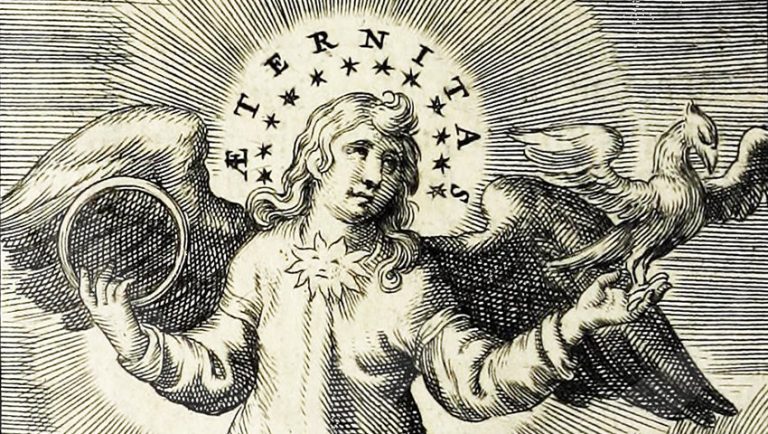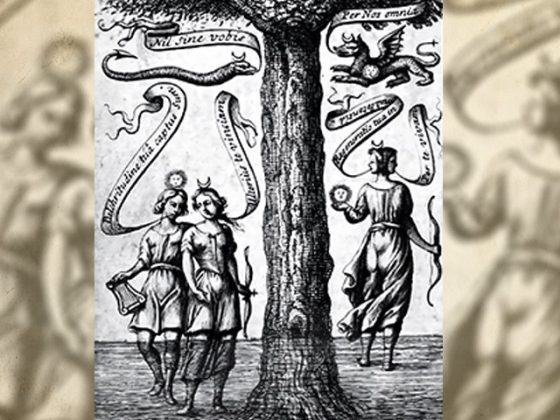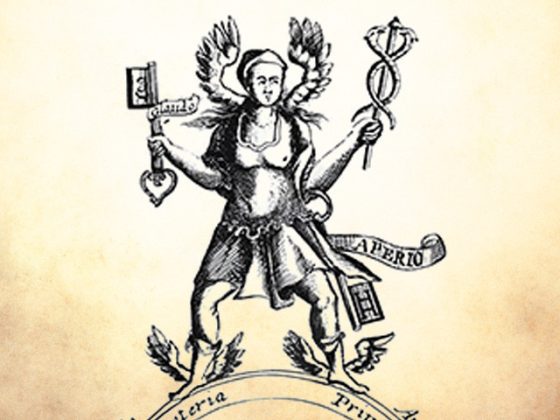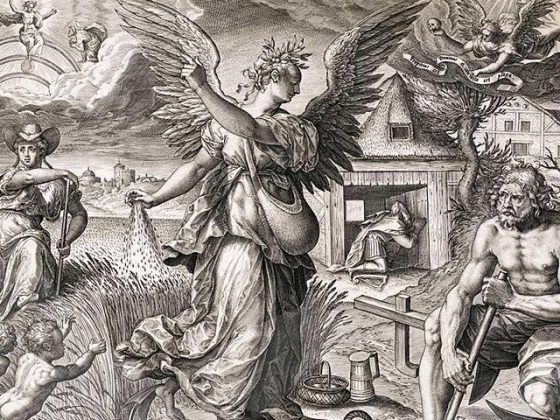Dearest friends:
It is with great pleasure that we send you the present engraving made by the Flemish brothers, engravers and book publishers, Raphael Sadeler (1584-1632) and Johann Sadeler (1600-1665), and which appears in the book entitled De Aeternitate considerations ─'Considerations on eternity'─, written by the German Jesuit Jeremiah Drexel (1581-1638) and published in 1631 in Amsterdam. This work contains nine Latin commentaries on eternity. Each comment is accompanied by an engraving.
The present engraving is entitled…
…CONSIDERATIO SEGUNDA. In quibus Natura reprasentet Aeternitatem
─‘SECOND CONSIDERATION. In which Nature represents eternity’─.
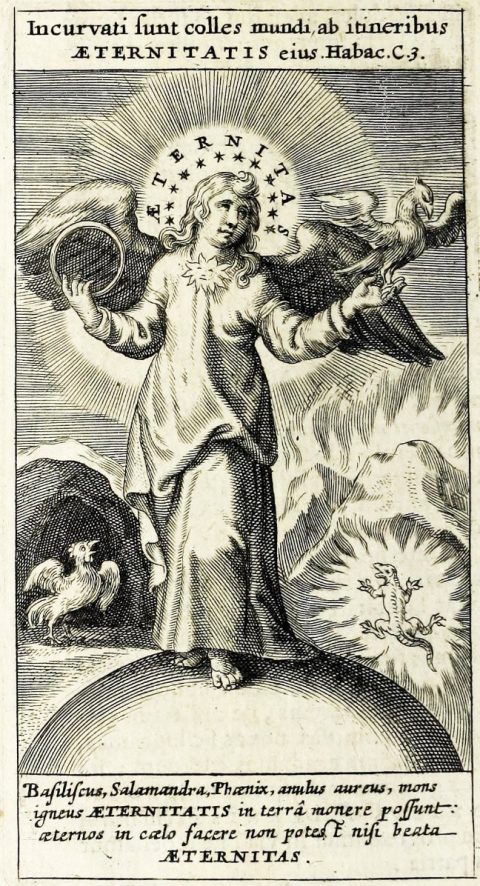
On the frontispiece is a quote from the book of Habakkuk, the eighth of the twelve minor prophets of the Bible:
«Incurvati sunt colles mundi ab itineribus AETERNITATIS eius. Habac. C. 3».
Translation: ‘The hills of the world bowed down to the ways of His eternity. Habakkuk. C. 3'.
As a variant translation we quote Habakkuk 3:6 of the Bible: “The perpetual hills have bowed. His ways are everlasting.”
We add a Latin text from the bottom/lower part:
«Basiliscus, Salamandra, Phoenix, anulus aureus, mons igenus AETERNITATIS in terra monere possunt: aeternos in coelo facere non potest nisi beata AETERNITAS».
Translation: ‘The Basilisk, the Salamander, the Phoenix, the Golden Ring, the Mountain of Fire remind us of ETERNITY on earth: but only the blessed ETERNITY can make them eternal in the heavens.'
The present engraving, in addition to its beauty, reminds us of the archetypes linked to eternity that we find in the sacred scriptures of all times.
That is why the commentaries on these archetypes go back to the times when even the very hills of our world prostrated themselves and prostrate themselves before the Secret Path.
To enter into the analysis of this engraving we must begin with the dreaded basilisk. The Hermetic legends showed it in a rather strange way and emphasized the care that the alchemist had to take with this creature, which was sometimes presented in the form of a kind of rooster but from which the tongue of a serpent came out and its body ended in the tail of a serpent. Extremely poisonous, to such an extent that a sting from such a creature had to be avoided. Obviously, going beyond the myth and looking for its possible connection with reality, we must conclude by describing it as the representation of the infra-human defect of lust. We must by no means forget that it was lust that caused the angelic fall of the first races that still retained divine characteristics. It was precisely lust that became the original sin that plunged Adam and Eve of the biblical Genesis into unconsciousness.
Secondly, let us now analyze the Salamander. To this end, let us turn to the V.M. Fulcanelli, who, speaking to us about this enigmatic creature, tells us:
“Salamander, in Latin salamandra, comes from sal, salt, and mandra, which means stable and also rock hollow, solitude, hermitage. Salamandra then is the name of the salt of the stable, salt of the rock, or solitary salt. […]
From these etymologies we can draw the conclusion that the salt, spirit or fire takes birth in a stable, a rock hollow, a grotto… That is enough. Lying on the straw of his manger in the grotto of Bethlehem, is Jesus not the new sun bringing light to the world? Is he not God himself in his carnal and perishable shell? Who then, has said: “I am the Spirit and I am the Life; and I have come to set Fire unto things?”
This spiritual fire, given form and materialized in salt, is the hidden sulphur, since during its operation it is never made manifest or perceptible to our eyes. And yet this sulphur, as invisible as it may be, is not an ingenious abstraction or a doctrine stratagem. […]
On the other hand, the very choice of the salamander leads us to believe that our alchemist must have searched for a long time and spent many years to discover the secret fire. The hieroglyph in fact hides the physicochemical nature of the fruit of the garden of Hesperia, fruit whose late maturity can only rejoice the sage in his old age, at the sunset (Hesperis) of a laborious and painful career.”
Undoubtedly, dear reader, we must be very patient when it comes to seizing the salt of the Spirit or this Secret Fire so necessary to change our nature. We need to be very judicious, very ethical in our work, because the fire we seek must be extracted from the rock or from the core of our sexuality. Such is the mystery of the salamander in the alchemical archetypes. It is curious that Fulcanelli calls our alchemical salt rock salt or solitary salt. Why?
For no one would imagine that such salt is the very fire of the Most High, and we shall undoubtedly always find it immersed in our solitude, imbued with our reflections and in our individuality. This is why in our engraving the salamander is attached to a burning rock. Let us remember, on the other hand, that our Secret Path is composed of THREE MOUNTAINS, and these mountains are igneous.
Let us now move on to investigate the figure that shows us the Phoenix Bird of mythology. In this regard, let us give the floor again to the Venerable Fulcanelli who, speaking to us about this singular bird, tells us the following in his work The Dwellings of the Philosophers:
“And so matter destroyed, mortified, then recomposed into a new body, thanks to the secret fire which is aroused by the one of the furnace, gradually raises itself with the help of multiplications, up to the perfection of the pure fire, veiled under the figure of the immortal Phoenix: sic itur ad astra. Similarly, the workman, faithful servant of Nature, acquires with the knowledge of the sublime, the high title of knight, the esteem of his peers, acknowledgement by his brothers, and the honor, which is more enviable than all worldly glory, to be among Elias’ disciples.”
The Phoenix Bird is the representation of the Philosopher's Stone itself, that precious gem that represents the solar individuals who have overcome time, disease and old age. That is why it is the third figure that we are investigating in this highly significant engraving linked to ETERNITY. There are some interesting evaluations of the elder brother FULCANELLI himself, let us see:
“It alone is witness to all the ages of the world, and it has seen the golden souls of the golden age turn into silver, from silver into brass, and from brass into iron. It alone has never given the sky and the world the slip; it alone scoffs at death, making it its nurse and mother, making it give birth to life. It alone has the privilege of time, of life and of death together. For when it feels laden with years, weighted down by old age and cast down by such a long sequence of years, that it saw to follow on after the other, it lets itself be carried by its desire and proper longing to renew itself by a miraculous death. Then it makes a pile which alone in the world bears no name, for it is not a nest, or a crib, or the place of its birth since it dies there; but it is not a tomb, a coffin, or a funereal urn because in it, it recovers its life; so that I do not know what another inanimate Phoenix is, being nest and tomb, matrix and sepulcher, at once a house for life and for death, which for the sake of the Phoenix, work together for this occasion. And, whatever it may be, it is there in the trembling arm a palm tree, that it makes a collection of small sprigs of cinnamon and incense, and on the incense, cassia, and on cassia spikenard; then with a pitiful look, commending its soul to the Sun, its murderer and its father, it alights or lies down on this balmy stake to get rid of its trying years. The Sun, favoring the just desires of this Bird, lights the pyre and reducing everything to ashes, revives it with a musky breath.”
And now we come to the fourth symbol, constituted in this engraving by a gold ring. This is the ring of the triumphants, of those who, having created their own PHILOSOPER’S STONE, can afford to become CHILDREN OF ETERNITY if the supreme will of the REAL BEING allows it.
That class of sacred individuals is shown by the central figure of the Adept who carries a sun on his chest, to assert that he is a SON OF THE SUN and not a lunar creature like the enormous multitude of our present Aryan race.
That sacred individual of whom we are writing has on his head, precisely, the word AETERNITAS, signifying ‘ETERNITY', that ETERNITY that has been earned by those who have confronted the PRINCE OF THIS WORLD, the Beast, whose secret number is 666, those who have made the THREE FACTORS OF THE REVOLUTION OF CONSCIOUSNESS their MOTTO.
We must emphasize the twelve stars that also surround the head of the Initiate or Adept. Such stars, being twelve, represent the twelve autonomous and self-conscious parts of every self-realized BEING.
We end this work by giving you some very opportune sentences for reflection:
“Eternity breaks all measure and destroys all comparison.”
Pierre Nicole
“Always hold fast to the present. Every situation, indeed every moment, is of infinite value, for it is the representative of a whole eternity.”
Goethe
“Eternity, a day without yesterday or tomorrow.”
Massilon
“When all that we have of mortal is clothed with immortality, we shall have a better sense of the dignity of our soul and the eminence of its qualities; we will then know what a Spirit is.”
Rubén Darío
“Hope is the strength that fills us with courage when we are in despair.”
G. K. Chesterton
MORS CERTA, HORA INCERTA.
─‘Death is certain, the hour is uncertain’─.
KWEN KHAN KHU


